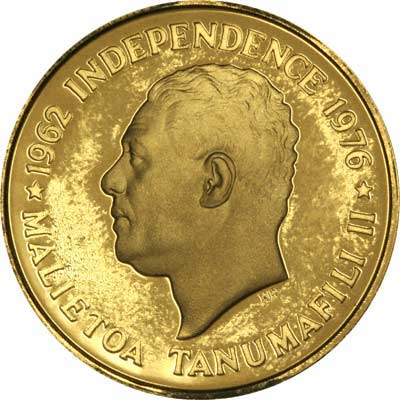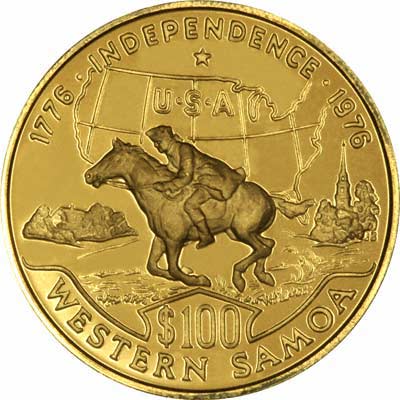|
Samoan Gold Coins
Brief Samoa History
From the CIA Website:-
New Zealand occupied the German protectorate of Western Samoa at the outbreak of World War I in 1914. It continued to administer the islands as a mandate and then as a trust territory until 1962, when the islands became the first Polynesian nation to reestablish independence in the 20th century. The country dropped the "Western" from its name in 1997.
From Wikipedia:-
Samoa, officially the Independent State of Samoa, is a country comprising a group of islands in the South Pacific Ocean. Previous names were German Samoa from 1900 to 1919, and Western Samoa from 1914 to 1997. It was admitted to the United Nations on 15 December 1976 (UN members) as Samoa. The entire group was known as Navigators Islands before the 20th century because of the Samoans' seafaring skills. It has a population of 176,710 (2001 census).
Contact with Europeans began in 1722, but intensified after the 1830s, when English missionaries and traders began arriving. Mission work in Samoa had begun in late 1830 by John Williams, of the London Missionary Society. By that time, the Samoans had gained a reputation of being savage and warlike, as they had clashed with French, British, German and American forces, who, by the late nineteenth century, valued Samoa as a refueling station for coal-fired shipping.
As Germany began to show more interest in the Samoan Islands, the United States laid its own claim to them. Britain also sent troops to express its interest. There followed an eight-year civil war, where each of the three powers supplied arms, training, and in some cases combat troops, to the warring Samoan parties. All three sent warships into Apia harbor, and a larger-scale war seemed imminent, until a massive storm damaged or destroyed the warships, ending the military conflict. At the turn of the twentieth century, the Treaty of Berlin split the Samoan Islands into two parts: the eastern group became a territory of the United States (the Tutuila Islands in 1900 and officially Manu'a in 1905), and are today known as American Samoa; the western islands, by far the greater landmass, became known as German Samoa after the British gave up claims to the islands in return for Fiji and some Melanesian territories. New Zealand troops landed in 'Upolu on 29 August 1914 and seized control from the German authorities, following a request by Britain that New Zealand forces take over a German radio station there. However, New Zealand soon became outmatched by residing German forces, withdrawing in 1915.
From the end of World War I until 1962, New Zealand controlled Samoa as a Class "C" Mandate under trusteeship through the League of Nations. There followed a series of New Zealand administrators. Approximately one fifth of the Samoan population died in the Influenza epidemic of 1918-1919, partly due to the negligence of New Zealand authorities in their failure to enforce a quarantine.
In the early 1920s, the Western Samoans began a campaign known as the Mau ("Strongly held Opinion"), a non-violent popular movement to protest the mistreatment of the Samoan people by the New Zealand administration. The Mau was initially lead by Olaf Nelson, who was half Samoan and half Swedish. (He continued to assist the organization financially and politically, though in exile, during the late 1920s and early 1930s.) In following the Mau's non-violent philosophy, the newly elected leader, High Chief Tupua Tamasese Lealofi, led his fellow uniformed Mau in a peaceful demonstration in downtown Apia. The New Zealand police attempted to arrest one of the leaders in the demonstration. When he resisted, a struggle developed between the police and the Mau. The officers began to fire randomly into the crowd and a Lewis machine gun, mounted in preparation for this demonstration, was used to disperse the Mau. Chief Tamasese was shot from behind and killed while trying to bring calm and order to the Mau demonstrators, screaming "Peace, Samoa". 10 others died that day and approximately 50 were injured by gunshot wounds and police batons. That day, December 28, 1929, would come to be known in Samoa as Black Saturday. The Mau grew, remaining steadfastly non-violent, and expanded to include a highly influential women's branch. After repeated efforts by the Samoan people, Western Samoa finally gained independence in 1962.
In July 1997, the constitution was amended to change the country's name from Western Samoa to Samoa, as it had been designated by the United Nations since joining the organization in 1976. The U.S. territory of American Samoa protested the move, asserting that the change diminished its own identity. American Samoans still use the terms Western Samoa and Western Samoans to describe the independent State of Samoa and its inhabitants. While the two Samoas share language and ethnicity, their cultures have recently followed different paths, with American Samoans often emigrating to Hawaii and the U.S. mainland, and adopting many U.S. customs, such as the playing of American football and baseball. Western Samoans have tended to emigrate instead to New Zealand, whose influence has made the sports of rugby and cricket more popular in the western islands.
Samoan Gold Coins
Western Samoan Gold Coins
Coins Wanted
We make an active market in almost all world coins, gold or otherwise, including Samoan gold coins. If you have any of these coins to sell, please contact us, or post them to us for appraisal and offer.
|
|

Obverse of 1976 Western Samoa 100 Tala
Countries Index

Reverse of 1976 Western Samoa 100 Tala
|


